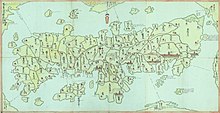Funai Domain
| Funai Domain 府内藩 | |
|---|---|
| Domain of Japan | |
| 1601–1871 | |
| Capital | Funai Castle |
| • Type | Daimyō |
| Historical era | Edo period |
• Established | 1601 |
• Disestablished | 1871 |
| Today part of | Oita Prefecture |

Funai Domain (府内藩, Funai-han) was a Japanese domain of the Edo period. It is associated with Bungo Province in present-day Ōita Prefecture on the island of Kyushu.
In the han system, Funai was a political and economic abstraction based on periodic cadastral surveys and projected agricultural yields.[1] In other words, the domain was defined in terms of kokudaka, not land area.[2] This was different from the feudalism of the West.
History[]
Funai had been the castle of the Ōtomo clan; however, Toyotomi Hideyoshi confiscated it during the lordship of Ōtomo Yoshimune. In 1601, , the cousin of Takenaka Shigeharu (Hanbei), received Funai Castle, and land rated at 20,000 koku; he had switched sides during the Sekigahara Campaign to support Tokugawa Ieyasu. The domain was then given to in 1634; however, as he died heirless, the domain was given to the Matsudaira (Ogyū) clan. The Matsudaira clan remained daimyōs of Funai until the Meiji Restoration.
List of daimyōs[]
The hereditary daimyōs were head of the clan and head of the domain.
- Takenaka clan, 1601–1634 (tozama; 20,000 koku)
- Shigetoshi (cousin of Takenaka Hanbei)
- Shigeyoshi
- Hineno clan, 1634–1656 (tozama; 20,000 koku)
- Yoshiakira
- Matsudaira (Ogyū) clan, 1656–1871 (Fudai; 21,000 koku)
- Tadaaki
- Chikanobu
- Chikayoshi
- Chikasada
- Chikanori
- Chikatomo
- Chikayoshi
- Chikakuni
- Chikanobu
- Chikayoshi
See also[]
- List of Han
- Abolition of the han system
References[]

- ^ Mass, Jeffrey P. and William B. Hauser. (1987). The Bakufu in Japanese History, p. 150.
- ^ Elison, George and Bardwell L. Smith (1987). Warlords, Artists, & Commoners: Japan in the Sixteenth Century, p. 18.
External links[]
- (in Japanese) Funai Domain on "Edo 300 HTML" (16 Sept. 2007)
- (in Japanese) Pictures of the remains of Funai Castle
- States and territories established in 1601
- States and territories disestablished in 1871
- Japanese history stubs
- Domains of Japan
- Ogyū-Matsudaira clan